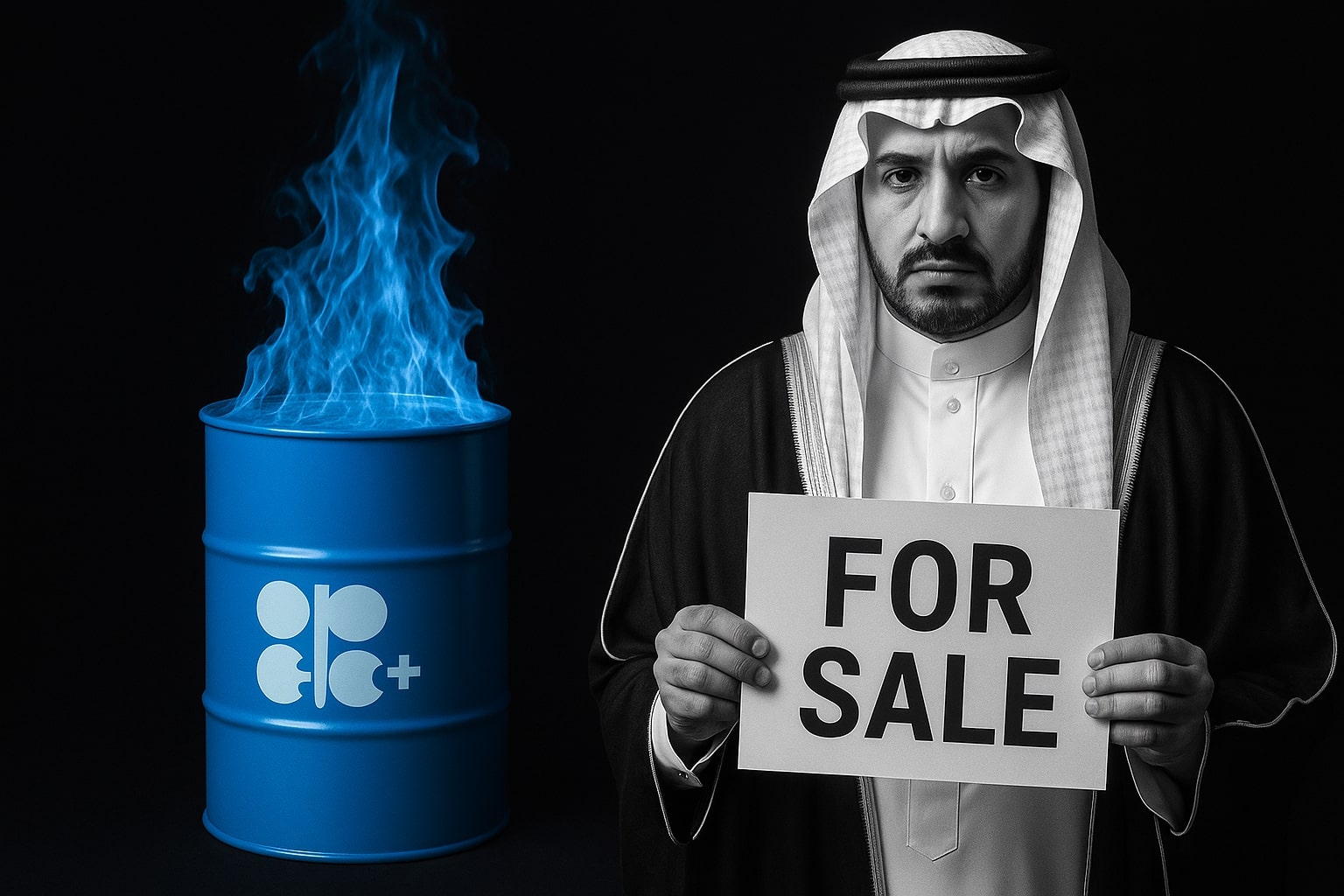
Oil Price Forecast - Oil Prices Slide Below $60; WTI and Brent Retreat
Crude futures drop over 1% with WTI at $59.79 and Brent at $63.70. Traders brace for further downside as global storage builds, yet ADNOC projects demand above 100M bpd through 2040 | That's TradingNEWS
Crude Oil Prices Today: WTI (CL=F) and Brent (BZ=F) Extend Losses as Demand Weakness Deepens and Global Inventories Rise
WTI and Brent Futures Retreat Amid Mounting Demand Concerns
Crude oil prices slipped further on Wednesday, with West Texas Intermediate (CL=F) futures down 1.27% to $59.79 per barrel, while Brent (BZ=F) dropped 1.15% to $63.70 — marking one of the weakest weekly starts since mid-August. Traders cited fragile demand in Asia and renewed signs of oversupply as the primary drag, with the U.S. dollar’s resilience adding additional downward pressure on dollar-denominated commodities.
Data from the American Petroleum Institute (API) revealed an unexpected 6.5-million-barrel build in U.S. crude inventories for the week ending October 31, amplifying bearish sentiment across the futures curve. As of early November, U.S. stockpiles have increased by 3.6 million barrels year-to-date, while gasoline inventories dropped 5.65 million barrels, highlighting a diverging picture between refined product consumption and crude accumulation. The Department of Energy (DoE) confirmed a 500,000-barrel addition to the Strategic Petroleum Reserve (SPR), raising reserves to 409.6 million barrels — a symbolic step in the ongoing effort to rebuild post-Biden era drawdowns.
Supply-Side Friction: OPEC+ Discipline Tested as Global Output Expands
While OPEC+ has paused planned output hikes until early 2026 following its modest December adjustment, the group’s production restraint is being overshadowed by increasing non-OPEC supply. The U.S. Energy Information Administration (EIA) reported domestic output at 13.64 million barrels per day (bpd) — a record level and 109,000 bpd higher than January 2025. Meanwhile, Kazakhstan’s Tengiz field maintenance trimmed national production by 10%, offering only temporary support to prices.
At the same time, Iraq canceled Lukoil cargoes due to tightened U.S. sanctions on Russian oil firms, disrupting trade flows and complicating OPEC+ coordination. Nevertheless, traders remain skeptical that these geopolitical disruptions will offset the structural oversupply building in global shipping data. According to Gunvor Group co-founder Torbjörn Törnqvist, “unprecedented volumes” of oil are now stored on tankers as sanctions on Russia and Iran reroute millions of barrels into “floating storage,” creating what analysts at Mercuria estimate to be a 1–2 million bpd surplus heading into Q1 2026.
ADNOC and Long-Term Oil Outlook: Demand Above 100 Million BPD Beyond 2040
Despite the near-term weakness, Abu Dhabi National Oil Company (ADNOC) executives reaffirmed a structurally bullish long-term view. Speaking at ADIPEC 2025, ADNOC Upstream CEO Musabbeh Al Kaabi projected that global oil demand will stay above 100 million barrels per day well into the 2040s, driven by aviation, petrochemical growth, and energy-intensive industries like AI data centers. The UAE’s production capacity stands at 4.85 million bpd, targeting 5 million bpd by 2027, supported by expansion at the Upper Zakum field, which could hit 1.5 million bpd ahead of schedule.
ADNOC’s chief, Sultan Al Jaber, emphasized that the world requires $4 trillion in annual investment in grids, data centers, and new energy infrastructure, underscoring the interplay between fossil and renewable demand. He noted that while renewables are expected to double by 2040, oil and LNG will remain central, with LNG projected to grow 50% and jet fuel demand up 30% over the same period. This long-term foundation offers critical support to producers with low-cost, low-emission barrels, a group in which the UAE, Saudi Aramco, and ExxonMobil remain dominant.
Geopolitical Disruptions and Tanker Storage Surge
The sanctions-driven reshuffling of crude trade is now producing measurable distortions. Commodity traders report a rapid increase in “oil on water” volumes, estimated at over 200 million barrels, as sanctioned crude from Russia and Iran struggles to find destination markets. Gunvor and Mercuria both warn that if sanctions are lifted suddenly, a flood of delayed cargoes could overwhelm markets, driving Brent temporarily below $60 per barrel.
At the same time, Libya announced a new onshore oil discovery, while Nigeria reaffirmed its target of 2 million bpd production by 2027. Meanwhile, Eni (BIT:ENI) and Petronas formed a $15 billion upstream joint venture across Malaysia and Indonesia, further expanding Asian supply capacity. The balance between sanctioned oil constraints and fresh project ramp-ups is therefore delicate — but tilting toward oversupply for now.
U.S. Energy Data: Inventories Rise, Refining Margins Narrow
The WTI curve has flattened notably, with front-month spreads near −$0.35, indicating weak near-term demand. U.S. refiner margins have slipped below $17 per barrel, down from over $25 earlier this quarter, reflecting narrowing profits from gasoline and diesel. The Mars US blend fell 1.34% to $70.71, and Louisiana Light dipped to $62.79, confirming pressure on Gulf Coast benchmarks.
Gasoline futures at $1.911 per gallon and natural gas (NG=F) at $4.256/MMBtu (−2.0%) both signal declining consumer energy appetite. The OPEC basket sits at $65.43 (−1.59%), below the key $67.50 comfort threshold that most cartel members use as their fiscal breakeven reference.
Read More
-
Oracle Stock Price Forecast - ORCL Surges Toward $251 as $300B OpenAI Deal Triggers Record AI Cloud Growth
05.11.2025 · TradingNEWS ArchiveStocks
-
XRP Price Forecast – XRP-USD Climbs to $2.27, Eyes $6.80 Target by 2026
05.11.2025 · TradingNEWS ArchiveCrypto
-
Gold Price Forecast - XAU/USD Slips Below $3,940 as Dollar Surge and Fed’s Caution Challenge 2025’s 50% Rally
05.11.2025 · TradingNEWS ArchiveCommodities
-
Stock Market Today: Tech and Biotech Power a Cautious Comeback — AMD, Amgen, Nvidia Lead Nasdaq Recovery
05.11.2025 · TradingNEWS ArchiveMarkets
-
GBP/USD Price Forecast - Pound Hits Seven-Month Low as Reeves’s Tax Warning Drive Pound Toward 1.3000
05.11.2025 · TradingNEWS ArchiveForex
ADNOC, Exxon, and Aramco Lead Output Expansion Strategy
In contrast to the weakening spot market, Saudi Aramco (TADAWUL:2222) reported a Q3 profit of $28 billion, up 6% quarter-on-quarter, supported by higher upstream volumes and improved operational efficiency. ExxonMobil (NYSE:XOM) and Chevron (NYSE:CVX) also exceeded forecasts, with Exxon confirming that Upper Zakum output expansion remains on track, and Chevron’s Hess acquisition boosting Q3 output beyond expectations.
Energy supermajors continue to consolidate upstream exposure while trimming exposure to high-cost, carbon-intensive projects. This dynamic is creating a bifurcated energy market — integrated producers thriving, while smaller shale drillers retreat as prices slide below $60.
Analyst View: Oil Market in Technical Downtrend but Long-Term Support Intact
From a technical standpoint, WTI (CL=F) faces resistance near the 50-day EMA ($62), while Brent (BZ=F) remains capped around $65–$66. Momentum oscillators confirm downside bias, with RSI at 38 and MACD negative, signaling risk of further weakness toward $58.50–$57.90 short-term.
However, the longer-term structure suggests stabilization within a $5 range, as physical fundamentals limit deeper collapses. Short-term rallies are viewed as selling opportunities, yet long-term investors could begin accumulating at sub-$60 levels — especially if geopolitical disruptions or OPEC+ interventions materialize. The market’s immediate trajectory remains bearish, but structural demand exceeding 100 million bpd beyond 2040 underpins a long-term bullish thesis.
Verdict: Short-Term Bearish, Long-Term Accumulation Zone
The TradingNews.com analysis categorizes current oil market dynamics as short-term bearish, long-term bullish accumulation zone. Near-term downside remains possible toward $58 WTI / $62 Brent, driven by weak Asian demand, strong dollar pressure, and bloated inventories. Yet, consistent producer discipline and ADNOC’s long-term projections suggest eventual rebalancing.
Recommendation: HOLD for institutional investors; BUY on dips below $58 WTI for long-term exposure.



















